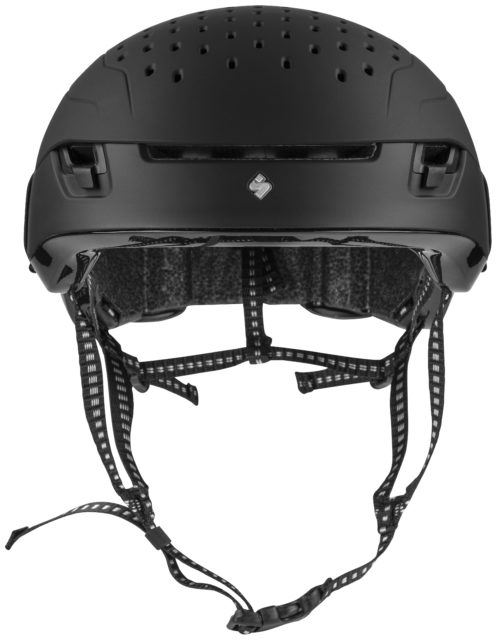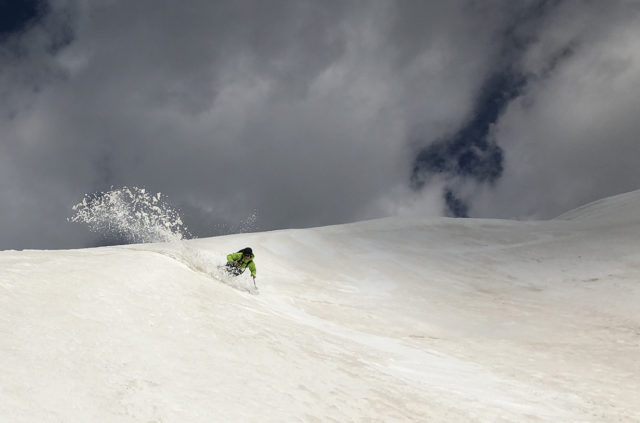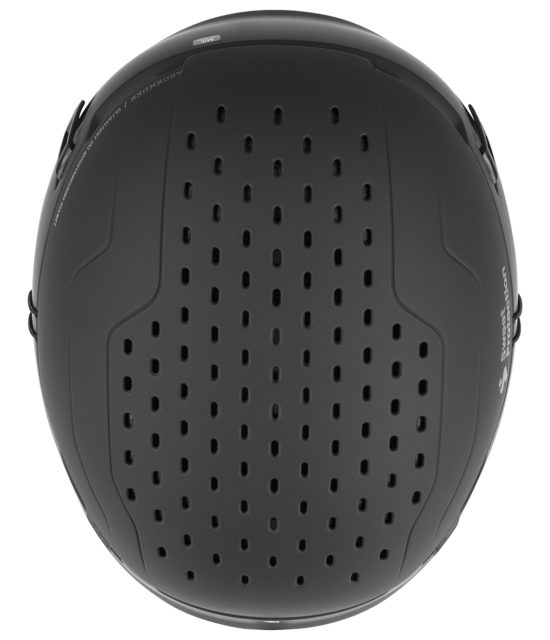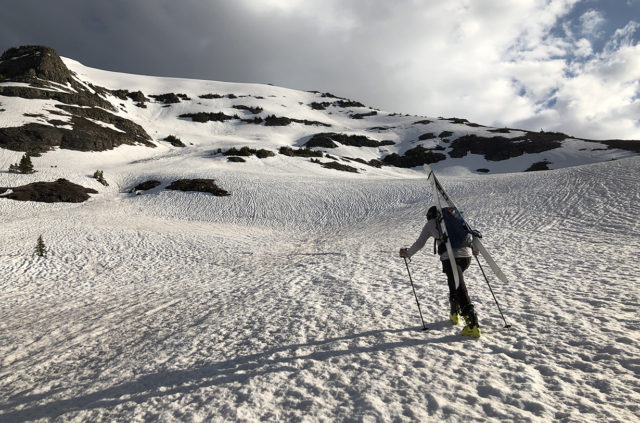Sweet Protection Ascender Helmet
Size Tested: M/L (56-59 cm)
Stated Weight (size M/L): 360 grams
Blister’s Measured Weight (size M/L): 392 grams
Stated Features:
- Triple certified for US Alpine Ski Helmet, European Alpine Ski Helmet, and Mountaineering standards
- Advanced Hybrid variable elasticity hybrid shell
- Dual-density EPS foam
- Headlamp clips
- Goggle-strap clips
MSRP: $169.99
Test Locations: Crested Butte & Front Range, CO
Days Tested: ~5

Intro
Over the past few years, a new category has emerged in the helmet market — helmets that are dual-certified for both skiing and climbing / mountaineering.
What started with the Salomon MTN Lab helmet has now spread to several manufacturers, and Sweet Protection is the newest one to add an addition to this category.
New for 2020, Sweet Protection’s Ascender and Ascender MIPS helmets are designed for backcountry skiers / snowboarders and mountaineers who want certified protection for both the up and the down, and who value low weight, packability, and breathability.

Sam Shaheen and I have both been using the Ascender Helmet this spring — here are our thoughts on how it compares to the competition.
Fit & Comfort
The first thing that Sam and I noticed about the Ascender is its shape. The Ascender looks a bit “flat” — it doesn’t extend super far down the back of the head. It also seems more oval-shaped than some other helmets like the Petzl Meteor and Salomon MTN Lab (which are a bit more circular).
My head circumference is right around 59 cm, which puts me at the very upper end of the range for the size M/L Ascender. I found the helmet to be pretty comfortable, though if I were to try it again, I’d probably opt for a L/XL to get a bit more room. As always, we highly recommend trying on a helmet (ideally with your goggles) before purchasing.
The Ascender has a very minimal fit-adjustment system that’s more similar to most climbing helmets than it is to skiing helmets. It has a thin webbing system inside the helmet that can be adjusted at four points. Sam and I both found that the Ascender’s fit-adjustment system took a bit of work to get dialed in, but once I had done so, I didn’t feel the need to mess with the webbing adjustments.

If you tend to fiddle with the adjustment on your helmets a lot, you may want to look to other helmets with more extensive / quicker fit-adjustment systems (e.g., dial-style adjustment or those with plastic cradle systems like the Petzl Meteor and Scott Couloir 2). I’d be happy to deal with a few extra grams on the Ascender for a quicker adjustment system, but your mileage may vary.
Dual Certification (or really, Triple Certification)
Like the Salomon MTN Lab and Scott Couloir 2, the Ascender Helmet is certified for both alpine skiing and mountaineering norms. Sweet Protection notes that the Ascender is technically triple certified, as it passes the U.S. Alpine Ski Helmet (ASTM F2040-11), European Ski Helmet (EN 1077:2007 – Class B), and Mountaineering (EN 12492) standards.

The idea that started the rise of dual-certified helmets is that dedicated alpine-ski helmets tend to be heavy and not offer much ventilation, so many ski mountaineers and backcountry skiers ended up using climbing helmets as many of them are lighter and better ventilated.
The problem is that most climbing helmets are not certified to the standards required for alpine-ski helmets, which left those people compromising safety for comfort and low weight.
Hence, the creation of dual-certified helmets. They are tested to both standards and tend to be lighter and more breathable than dedicated ski helmets.
Goggle and Headlamp Compatibility
The Ascender is a pretty minimal helmet, but it does include headlamp and goggle-strap attachment points.
The Ascender’s headlamp clips are pretty standard and have worked well with the Black Diamond Icon and Spot headlamps.
Rather than use a strap at the back of the helmet for securing goggles, the Ascender has elastic cords on each side of the helmet that attach and detach easily to accommodate a goggle. The cords are pretty short, but I’ve only had compatibility issues with goggles that have super wide straps (e.g., the Scott LCG Evo with its 50mm-wide strap). Other than that, the cords have worked well.
One thing to note — when the cords aren’t attached to the helmet, they create little “wings” that flip up off the side of the helmet. So if you like to look goofy, this’ll be a plus. And if you don’t want to look like an alien who found their way into the backcountry, I’d recommend checking occasionally to make sure the cords haven’t come undone.

The Ascender has a very flat front brim which means that, for all the goggles I’ve used with it, there is a bit of empty space on either side above the goggle. I’ve still been able to get a good fit with the Sweet Protection Firewall, Smith I/O7, Smith I/O Mag XL, Smith 4D Mag, and Giro Axis, the Ascender just doesn’t seem to offer that seamless integration that some dedicated alpine-ski helmets do (which, again, I think is due to the Ascender’s flatter brim).
Ventilation
The Ascender has a lot of vents. First, it’s got the standard front vents (above the goggles) and back vents to create front-to-back airflow. Then it has approximately a ton (I didn’t feel like counting) vents on the top of the head.

The Ascender is one of the best-ventilated ski helmets I’ve used. Combined with its low weight, this made the Ascender my go-to helmet for late-spring and summer ski missions where I know I’ll be spending a lot of time walking around in the sun and want to keep my head protected.
Weight
At a measured weight of 392 grams for a size M/L, the Ascender Helmet is quite light. It’s a bit heavier than the dual-certified Salomon MTN Lab, but the Ascender is still significantly lighter than most dedicated alpine-ski helmets.
It’s also worth noting that the Ascender’s “flatter” shape makes it pack down smaller than most other helmets that have shells that extend lower down the back of the head. I don’t often think about a helmet’s packability, but I did notice that I was hitting the Ascender on less stuff when it was strapped on the outside of my pack as it is significantly lower profile than most other helmets.
For reference, here are our measured weights for a number of both skiing and climbing helmets. We’ve also listed in parenthesis the standards that each helmet meets. Keep in mind the size differences to keep things apples to apples.
248 g — Petzl Meteor, size S/M (climbing + ski touring)
248 g — Black Diamond Vector, size S/M (climbing)
301 g — Petzl Boreo, size S/M (climbing)
346 g — Pret Cynic AT, size M (alpine skiing)
350 g — Smith Maze, size M (alpine skiing)
379 g — Salomon MTN Lab, size M (climbing + alpine skiing)
392 g — Sweet Protection Ascender, size M/L (climbing + alpine skiing)
399 g — Scott Couloir 2, size S (climbing + alpine skiing)
449 g — Pret Cynic X, size M (alpine skiing)
505 g — Smith Vantage MIPS, size M (alpine skiing)
530 g — Sweet Protection Igniter MIPS, size M/L (alpine skiing)
596 g — Sweet Protection Switcher MIPS, size M/L (alpine skiing)
689 g — Sweet Protection Trooper MIPS, size M/L (alpine skiing)
710 g — Sweet Protection Grimnir TE, size M/L (alpine skiing)
Who’s It For?
Backcountry skiers and snowboarders who prioritize safety, low weight, packability, and ventilation.
If you only ski in the resort, I’d recommend a dedicated ski helmet (Sweet Protection makes several good ones — see our Winter Buyer’s Guide).
And if you’re specifically looking for a helmet to solely use for climbing, go with a dedicated climbing helmet.
But if you like to spend your time hiking / climbing up mountains in order to ski down them, the Ascender is worth a look. It’s light, very well ventilated, and it’s certified for both skiing and climbing standards. There’s also a MIPS version available for $199.

As for how the Ascender compares to the other dual-certified helmets, I’d say it mostly comes down to fit. The best helmet is the one that fits your head and that you’ll actually wear. So if you’re interested in the dual-certified category, I’d recommend trying on a few options (Ascender, Scott Couloir 2, Salomon MTN Lab) and see which one fits best. They all have subtle differences in terms of features, fit-adjustment systems, and weight, but I think fit should be the primary differentiator as they all basically do the same thing — protect your head while climbing and skiing / snowboarding.
Bottom Line
With the Ascender Helmet, Sweet Protection has made another solid addition to the category of dual-certified skiing / climbing helmets. It’s lighter and breezier than most dedicated ski helmets, but it’s more protective than most dedicated climbing helmets. For skiers and snowboarders who like to go both up and down mountains, the Ascender is worth a good look.
